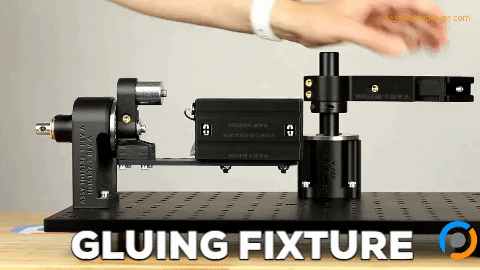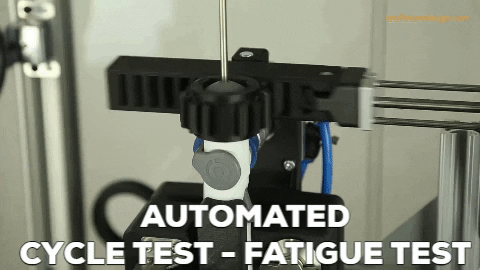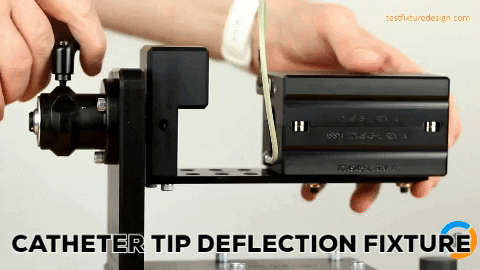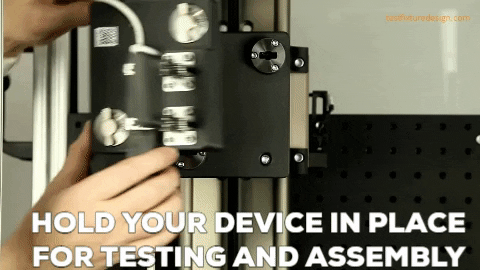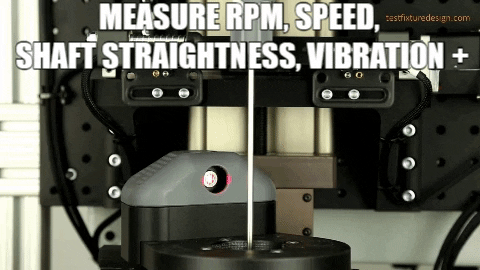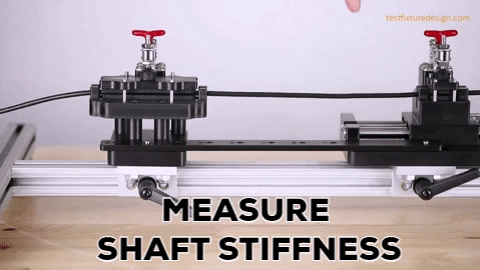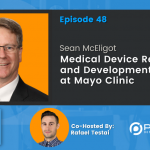Hardik Kabaria | Lattice Structure 3D Printing – 3D Printed COVID-19 Test Swab
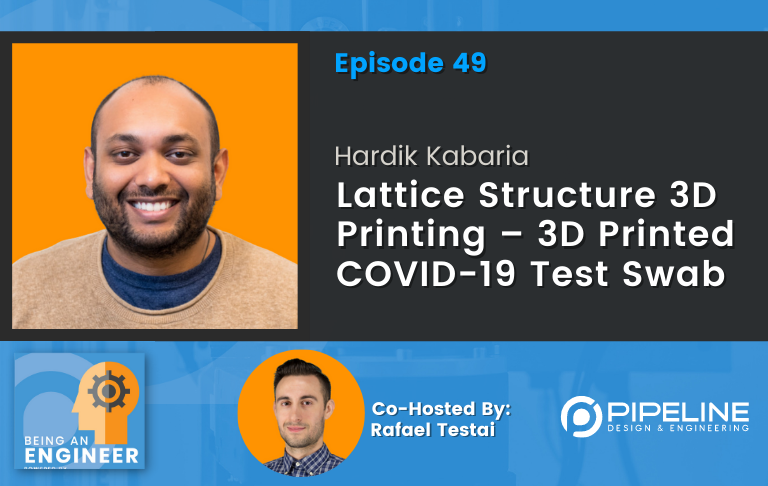
Who is Hardik Kabaria?
Hardik Kabaria is the Director of Software Engineering at Carbon. His engineering background and knowledge of software allow him to lead the team to produce Lattice Structure 3D Printing – a 3D-printed COVID-19 Test Swab to solve the sudden swab shortage.
Hardik Kabaria is in charge of Carbon’s Design Engine development. Hardik also works on the surface and volumetric parameterization, parametrizing topology changes, working with an implicit neural representation of 3D geometry, linear algebra-mixed-integer solvers, PDE constrained optimization tools, and physics simulations based on finite element framework.
EXPAND TO VIEW EPISODE TRANSCRIPTION
SUMMARY KEYWORDS
design, carbon, create, engineer, swab, lattice structures, means, structures, topology optimization, geometry, midsole, printer, material, parts, lattice, product, idea, linear algebra, software, problem
SPEAKERS
Hardik Kabaria, Presenter, Aaron Moncur, Rafael Testai
Presenter 00:00
The being an engineer podcast is a repository for industry knowledge and a tool through which engineers learn about and connect with relevant companies technologies, people, resources and opportunities. Enjoy the show
Hardik Kabaria 00:16
You have a lot of freedom under geometry you can produce
Rafael Testai 00:32
Hello, everyone and welcome to the being an engineer podcast. I am your co host, Rafael Testai today we got another very special guest Hardik Kabaria and he is a director of software engineering at carbon in this role, he leads the development of carbons design engine, he works on a variety of computational geometry and mechanic mechanics algorithms, including surface and volumetric parameterization parameterizing, topology changes, working with implicit neural representation of 3d geometry. And if by all means, as I’m reading this description if your listeners if the listeners are wondering what some of these terms mean, we’re gonna go over them rest assured, linear algebra, mixed integer solvers, PDE, constrained optimization tools, and physical simulations based on finite element framework. Before carbon, he completed his PhD at Stanford University in the field of gender generating tetrahedral discretization, for changing geometries and evolving topologies. Sounds like I’m going to be speaking with someone extremely smart Hardik, Welcome to the show.
Hardik Kabaria 01:40
Thanks for having me.
Rafael Testai 01:41
Absolutely. So why don’t you tell us a little bit about yourself? How did you decide to be an engineer? What’s your story?
Hardik Kabaria 01:48
Oh, how did I decide to be an engineer, I cannot even think of one sort of point in time where that decision may have happened. But it very early on. In my age, I was quite interested in paper airplanes. I had I remember having a book where there were like 100 different designs you could make, made a sort of project out of it. And that got me interested in being an engineer, especially something related to mechanical aerospace. I didn’t end up going in exactly any of those places. And fast forward with my bachelor’s in mechanical engineering in India. And that led to a Master’s and PhD here at Stanford. And I’ve moved around a little bit started in mechanical engineering, then got interested quite a bit in computational geometry. did my PhD focused on that? And then the rest is history sort of became a software engineer in that space with carbon since 2015.
Rafael Testai 02:50
Okay, so as I said before, I’m going to start defining your complex definition that you have on LinkedIn, your biography, piece by piece, so we can put it all together. So you worked at carbon, could you explain to our audience who carbon is and what you do?
Hardik Kabaria 03:09
Sure. So carbon is a 3d printing company. In a little bit more elaborate way, we have created a new, fundamental way to manufacture products within the realm of additive manufacturing, a new process, we call it digital light synthesis. So we create this hardware, which is the printer, we are the inventor of the process. And we also invent the chemistry, which are the residents that you can use on this printer to create parts, sort of fundamentally different thing is our process as innovators, so you can print things significantly faster. These are all polymers, so plastics. And because we can print faster, we have allowed ourselves to use certain chemistry that enables us to create parts that have high end properties. That means it is not just for prototyping, it is for manufacturing. Fast forward a few years we have there are several high profile customers that are using our technology. Suddenly printer version, and the software that drives the printer all together to create parts like readers creates mid soles, and these are at scale, in manufacturing environment, in factories, and these parts are real so that you can buy that from the consumers website like you can buy the 3d printed midsole powered shoes from adidas website. So that’s in a nutshell company carbon. We work at the intersection of saw hardware, software and material science, as I alluded to before, my role is in software team. Within that we early on, we realized that one of the ways we can accelerate how mechanical engineers find more and more applications that will be manufactured on our printer is we give them access to ways of designing for additive manufacturing. Just like you Think injection molding is a manufacturing processes very mature, there are many software tools around around the world that can help engineer design the parts that are right for them that can be produced robustly with a high yield. And without any error using injection molding processes new so it has his own constraints, it has his own freedom. So we wanted to create a design engine or design tool that specifically takes advantage of the manufacturing process that carbon had invented. Even more specific, we thought lattice structures are this structures that are architecture that can lead to very phenomenal or fascinating mechanical properties compared to a form or encumbered material. And so if we give access to these lattice structures as a meta materials to mechanical engineers, they will be able to design cards that will have superior performance compared to incumbents, and hence, they might be interested in designing this way. So that started the idea of creating the protocol design engine. As we know today, I was sort of the first engineer on the team.
Rafael Testai 06:07
Before we go into that you just downloaded a lot of information, you can ask me some follow ups before we go into the details, please. Okay, so if I understand correctly, just to recap, carbon, it’s a 3d printing company, not only you make the printers, but you make a a filament or a typo. So
Hardik Kabaria 06:28
yes, it’s basically liquid resin, and that the printer shines a UV light on it. And that starts a chemical reaction that converts the liquid into solid.
Rafael Testai 06:39
Okay. And once it solidifies, the you produce some very special properties, you said that could be used as soles of shoes, is that right?
Hardik Kabaria 06:49
Yes. So this part is just about the process. So the process is rather, you can think about it in a very simple way, wherever you shine the light, the liquid becomes solid. So our printer is basically a very fancy projector, where the UV light is shining this light in a particular places where the liquid turns into solid. The beautiful thing about that is you have a lot of freedom and the geometry you can produce. That means you can produce really complicated geometry using this manufacturing method compared to what you might do with other traditional methods of manufacturing. So I’ll pause there first. And if that makes sense, I can elaborate further and why lattice structures could play an important role in that argument.
Rafael Testai 07:31
That was actually going to be my next follow up question because I design in SolidWorks. And use Mark forge a lot here, pipeline team pipeline, tell us where I work at the sponsors this podcast. And we always think about the 45 degree angles that we need to use in order to avoid using supports in additive. So how is designing it for carbon different than that.
Hardik Kabaria 07:55
So in some ways, it certainly is similar, that you do need support if there are big overhangs or islands as we like to call it. But our process, and there’s also a little bit more complicated, because we have a pool of resin out of which you’re pulling the pot out. So you can create a lot of suction pressure at the same time, there is heat being generated by this chemical reaction. So the parts could work as well. So we have created design guidelines, that is accessible to all the engineers in carbons ecosystem that help them design the part or maybe alter the design. So that’s sort of at the high level. Yes, this manufacturing process satellites, any anything else has its own constraints, and it has its own freedom. The biggest freedom I think is you just like you may have experience with my Porsche or any other printer is that the you can create very complicated structures. And one of the things that academics in this area has been excited about is lattice structures. Structures. Yeah, and I’ll define a little bit. So, lattice structures are basically a repeated pattern that you can fill the 3d area with and each structure has a unique shape, right. So, you can say a few few cylindrical beams coming together is one structure. And depending upon the size of the beam, the angle of the beam and the diameter and how they connect together depending upon how load how much load you apply, it may perform or bend differently, right. So that’s sort of our simple mechanics ideas. Given the 3d printing technology manufacturing process, we have can allow for very complicated structures to be manufactured, you can really take the idea to the top that basically means you can define more and more complicated structures and still the manufacturing process can successfully produce them at yield with the right amount of repeatability and all the other things that come with the manufacturing process. So that has given birth to this idea of this I’m based on lattices. And by any means, I wouldn’t say that carbon is the one that introduced with lattice structure based design, I would say has been studied in academia for since 1980s. But it hasn’t really led to a plastic product that is available specifically in consumer world that is designed based on larger structures. And it’s available to people. So it’s available to mass that means it’s manufactured at scale. So I would say that is something that carbon did it first. And the example is one of the example is the midsole that is created in partnership with Adidas. So midsole traditionally is done with form, you have a form that does the job of cushioning and giving support to the person that is running or standing or walking in the shoes. In this case, that form part is replaced with a set of structures, which are repeated structures, these are engineered structure, they’re supposed to do a particular job, that means you can engineer them to your liking, you can say that if I compress it from the top, it’s gonna propel towards forward. So that means it gives you sort of a positive kickoff for a momentum boost. You can engineer their performance
Rafael Testai 11:18
in sports when we achieving, just playing devil’s advocate.
Hardik Kabaria 11:22
So 100%, I cannot talk about how a particular body of sports could think about performance of any particular product. As technologists, what I think about is, what we want to do is you have a set amount of space, how thick midsole can be, or how thick a helmet can be, how heavy a helmet can be. Within that constraints, what is the best thing we can do? Can we create a superior helmet by designing the structure so that they are the safest? Or they will reduce the linear or rotational impact the most? In terms of shoe? Can it give the right amount of energy recovery? So yes, I by any means I’m neither expert nor I would say, I have any authority to comment of what sports body would think about these products. But from pure engineer technology perspective, I think this is a fascinating area, because we can achieve a better tuned mechanical properties out of a part to what an engineer might want.
Rafael Testai 12:26
A See, I encourage I agree with you, this is very interesting. I encourage all the listeners, if you’re not driving too quickly open up a browser and just type in lattice structure 3d printing, or 3d printing deelish Adidas shoes, so you can visualize what it is that we’re talking about here. Talking about, I went to one of the biggest medical device shows called MD and M West, just last month, and I happen to see the Adidas shoes that you’re talking about with the printed. So there were over $300 Is there something why is this technology so expensive? Or it seems to be expensive? Is there a reason why?
Hardik Kabaria 13:06
So I cannot comment on the consumer price. So first of all, make it clear that Adidas is a partner with which we have the make medicines at the end end goods, the product, which is the midsole and the upper and the final shoe that is sold, it is the product of Adidas but you are raising one interesting question is that when we replace these foam midsole with a lattice structure, but Mr. Mixel is it same at the manufacturing costs, because that’s something that we are really interested in. So 100% not it is more expensive today and partially is because of the volume and the scale, the scale at which the the amount of material that has been consumed is still minuscule compared to the form industry. And as we all know, up to a point things get cheaper, as more and more of the same material is consumed. So and that is already we see that happening already. That basically means we have the same material or the similar same raw material components being used across many different application by several of our customers to produce lattice based design, whether it’s midsoles for readers, saddles, biking helmets, enhance overall the cost of the raw material comes down and hence slowly the same component will become cheaper, and so on so forth. So that sort of expands the total applications are different mechanical components that can be made with the same technology being the printer and the reason we have and the software that AIDS mechanical engineers to design parts. At the same time there is also the aspect of performance. It’s quite possible there are higher performing shows higher performing helmets, and the companies that sell these goods might be interested in Creating a premium segment. So like I said, we do not go under price, nor we influence it, what our customers sell the products at it is their business, they understand each of these products and markets much, much better than us. We are a tool in the toolkit, what we extend them is yet on a innovative manufacturing process at the same time and awesome way to design so they can design parts that aesthetically look cool. That achieved the mechanical performance, maybe even one up than what they have been aiming to achieve, right and do that very, very fast. So that means we try to reduce the time from the product conceptualization to the market, because in additive manufacturing, you don’t have tooling costs or the tooling time. So that’s sort of our vision and ideas.
Rafael Testai 15:50
Yeah, thank you for making the distinction between the pricing of Adidas and carbon is two different subjects. I should have been more specific in my question. And also when I said cheating, I should rephrase it to more of an advantage if one is trying to maybe propel him or herself forward.
Hardik Kabaria 16:07
Yeah, I’ve as an engineer, I think about you have the constraints. And within those constraints, everything I do is hope if I can make the lives better, whether it’s for the athlete or patients, then it’s a fair game. But anyhow, again, this I have no legal authority of No, no sports body authority. Yeah, but it’s a pure engineering mindset.
Rafael Testai 16:29
So I come from a biology background, my degrees in molecular biology and genetics. And I’m working on my second degree in mechanical engineering. And this is why I’m going to ask you this question. It may come out of nowhere. I didn’t even ask you this question before the podcast started, but it popped in my head, the grapefruit, if we look at biomimicry, which is you see in nature as inspiration for engineering or any kind of technology advancements, what they look at their Palmilla, the grapefruit and the skin of the grapefruit that the white part is very thick, and scientists have used it to emulate it because it’s a great shock absorber and your technology and carbon, it kind of reminds me of the pomelo skin it is does it look to you like or no?
Hardik Kabaria 17:14
Yeah, so that’s certainly a good point. And I would say there’s a whole field around it, where people are actually trying to design stuff that is inspired from nature. And I’ll give you some more example that has come my way as I have delved into lattice structures is you have woodpecker, and they have sort of a design around the brain, that as they keep packing the wood, it still protects the brain, in the same amount of torque or force or jerk was applied to human brain, it would suffer concussion. So clearly there is a lot in the nature that we can inspire from and design, quite often that we have seen is that the scale at which nature has backed engineering, this design is amazing. What I mean by that is whether you take the skin of the fruit or woodpecker or any of these examples, it is very, very intricate design once you put it on the microscope, and I do not think we always have the right manufacturing technology to create design at this high resolution. So that’s sort of number one, we are slowly getting there. 100% we have metal 3d printers that can print not at carbon, but in the world, where they can print a very high resolution with carbon, we are trying to sort of taking a step towards that we are bringing a slightly higher resolution design availability for polymer products. I by no means we are there, right by no means we are still in millimeter scale. But it still means that you can design very complex parts that may have inspired from that has inspiration from nature, and put those design in. And I’ll give one more idea where our own design ideas have stemmed from. There are these polymer, it’s called a block of Parliament. And the there’s a whole area that has studied these structures, they have these block copolymer have phenomenal energy absorption properties. And there are scientists who studied their structures at nanometer scale that has led to the area of triply periodic minimal surfaces. And what we do is take advantage of those inputs help them put in lattice structures at a different scale, significantly different scale, but they still the structures that was actually found in other material is very useful at an absorbing energy or postponing stain densification and it’s helping some of our customer design very phenomenal parts. So we will transition right there.
Rafael Testai 19:45
So when we look at lattice structure, 3d printing, for those of you that are listening and maybe driving who have not had the chance to maybe look at a picture of that, I’m going to try my best to describe it. I think of it as like maybe a pile of toothpicks or something like that. Just How could you give our listeners a quick visual? Before I ask my question?
Hardik Kabaria 20:04
That’s certainly one way to think about it, I was going to say, you have a pile of toothpicks, but a very diligent engineer that is replacing each toothpick nicely, and is also maybe selecting toothpicks of different diameters, and creating this web. But this web is may look organic, or may look stochastic, haywire, chaos, but it is not. It is engineered, and it is engineered to do a particular purpose, whatever that purpose of that product might be. And I will say that pays in maybe a couple of tournaments with lattice designers.
Rafael Testai 20:39
Okay, very well said. So, when I think of when I looked online of lattice structure, 3d printing, they all look like what we just described. So I think to myself, is there a disadvantage for looking that way? And not being a traditional maybe like a slab of 3d printing material? Imagine like a slice of bread or something like that. That’s continuous? Because it has holes in the material, right? When it’s when it was the word we use lattice, it has the holes between it has this advantage or now?
Hardik Kabaria 21:10
Yeah, so I think it’s both advantages and disadvantages. Like, I would be remiss if I say this is free. It’s about quite often lattice structures are used to reduce the weight, like you don’t need a full blob of material. For every task you needed to do, right? Imagine it’s supposed to support some weight and not collapse. And you only have a few materials to select from. So you’re gonna choose a material that is slightly safer sides, a slightly an overkill. And at that point, you could choose to have a full slab of material, or you can optimize for stiffness to mass ratio, which is most often we engineers do, even if we are not using 3d printing, 3d printing and lattice structures, that idea has one more degree of freedom, that means you can choose the right structure, and the right level of fidelity, right, whether it’s a big hole small holes, is the same size of holes everywhere else, same topology everywhere. To optimize the purpose, whatever is the purpose, and I may push back on this loaf of bread loaf of bread is not continuous either, it actually has holes. It’s exactly like lattice structure.
Rafael Testai 22:19
It is a porous surface.
Hardik Kabaria 22:22
Surface, it’s actually very good example for a lighter sector with me, but then what we do.
Rafael Testai 22:28
Alright, so I came across the term topology optimization. It really caught my eye a couple years ago, I’m someone that optimization really resonates with me, even the way that I have things around my house, where I put my clothes in my room. So for instance, if I do my break, I’m almost finished with my example. But if I’m doing a breakfast in the morning, I’ll put my oatmeal next to my honey and next to the cinnamon in the same drawer, because I know I’m going to do it all together. So topology optimization has been something that really resonated with me, and I wanted to ask you, is having perhaps a passionate topology optimization, something that led you to where you are now? Is that how you started the journey,
Hardik Kabaria 23:11
I wouldn’t say that, I will say I, I got deeper into topology optimization more during my work at carbon. My sort of the way I came about here is more about geometry, processing geometry. And there was like creating tools for people who do topology optimization. So I’ll give a very simple example. So quite often, people make propellers, propellers for engines and submarines and whatnot. So one of the things people have looked at for ages and they continue to look for, is having the right shape of the propeller to do the job is supposed to do. And this part of it is some idea of either topology or a shape optimization. And what I did during my master’s PhD is create tools, so that we were doing this job of optimizing, it’s easier for them to perform physical simulation, specifically in the context of finite element analysis. So I would say topology optimization wasn’t really my field, I wouldn’t say I’m expert in the field even today. But I have had to go deeper into it as part of the trade. Okay,
Rafael Testai 24:27
processing geometry. So if I understand this correctly, if you download that geometry into the software that you will make, I’m making a lot of assumptions here in a second, please correct me everything I say. But if you download a geometry into a software that’s going to optimize it for His purpose. How does the software know like you’re the person behind that that codes everything?
Hardik Kabaria 24:50
Yeah, so Geometry Processing is sort of a wide term and I’ll I’ll tell what the term is and then I’ll tell you what we do at carbon. Yeah, pick your favorite CAD tool. You, you draw, let’s say a few different objects and you use sort of Boolean them. So intersection union difference, you can create a CSG, tree or graph. Geometry Processing, in a way is what’s happening behind the scene. When you do that. Right. Now that area is I would say up to an extent, pretty well figured out. Because you see SolidWorks, you name it creo. All of these tools very successful. Entertaining the needs of a mechanical engineer in all the different industries. However, this problem is a little bit more complex, when you start designing with even more complicated structures, where instead of having a 1050 different beams, like this toothpick example, in lattices, now we have 10,000 different beams. So the number of parts are significantly higher if you think about your primitives in lattice structures compared to other traditional designs. And hence, now the same geometry processing, you have to do it on a very different scale, you have to do it very fast. And you have to do it so that you can handle so many different parts. And that’s sort of the job we do so for Geometry Processing for us is doing the simple operations on primitive. And, but we want to do it for the type of designs that are often used in additive manufacturing, which may lead to have, which often have like 10s of 1000s of different primitives instead of like 100 or 1000. Okay,
Rafael Testai 26:26
perfect. I wanted to take a quick moment to remind our listeners that they’re being an engineer podcast is brought to you by pipeline design and engineering, pipeline partners with medical and other device engineering teams who need turnkey equipment, such as cycle test machines, custom test fixtures, automation, equipment, assembly, jigs, inspection stations, and more. You can find us on the web at www that team pipeline, the US, and I’m here with the heart geek that works at carbon. And I want to ask you, this is the story of how we found you there was an article on a very famous magazine called machine design, you can find that machine design.com. And the article talks about how you there a carbon develop a viable swab prototype within a couple hours. So first, could you define to us, give us a visual What do you mean by a swab, because when I think of a swab, I think of like a Q tip.
Hardik Kabaria 27:23
Yeah, and I was complete, I had no idea what swab was either, before this problem hit us. But as we all know, early on, in the pandemic, there was a shortage of COVID 19 test swab, and this particular swab, the technical term is nasal pharyngeal swab. If you or anybody has gone through COVID-19 test, you sort of remember it as a not so happy experience, there is a swab, that’s pretty long, that goes quite a bit in your nasal cavity. And the person who’s doing the test will roll the swab a few times before the direction and try to collect the mucosal content. And they tried to detect Why risk for wider content in that biological sample. The swabs as I knew, then, I still know is a very simple object. But because the supply chain was broken, there was a shortage of swabs. And that led to one institutes, specifically, Beth Israel, Deaconess Medical Center in Boston, to think about can there be alternative swabs which are 3d printed, because the normal supply chain for the golden swab that is traditional is broken, and there is a shortage of? That’s where the problem was introduced to us and many other 3d printing companies as well. We, we started looking into it like what swab looks like, what’s the purpose of it, how does it function, and we did think of an idea that maybe we can design the tip of the swamp using lattice structure. So that basically, when you when somebody sort of rotates it around the axis, it will collect the mucosal content within it, and then you’ll be able to pull it out and do the test as a test. We have developed this tool called design engine, which is specific for lattice design for additive manufacturing. We use the same tool to create this design. And we started printing prototypes on the printer that we have. So within days, we created a few prototypes. And we we sent it out to a couple of clinical institutions where we got some feedback like, oh, this this thing is working. This is not working. This is how you might want to change design. And we started the design iterations for the swab. So that’s sort of the story how we came about working on this project.
Rafael Testai 29:52
So before the original swab is a cotton at the bottom at the end, yeah. Okay. If, for some reason, it just seems like it would be a little more painful to put us 3d printed swab, right
Hardik Kabaria 30:08
100% 100 question, we all felt the same, the first design got the same feedback that the material you have is pretty stiff, it is not a pleasant experience. But we were able to iterate. And there are many different ways to create a flexible design, specifically using these ideas of lattices, even when the material is stiff. So we applied this concept, and we went through those user studies to get to a place where this will be designed, were went through a clinical study, and it was perceived as its equivalent experience. So it’s not any worse than the golden swab, which is what was used at
Rafael Testai 30:50
changing subjects here. First, congratulations on that to you on the whole carbon team for helping with COVID. So I received some here in the middle of my second degree in mechanical engineering, some of my mentors and advisors and some of my mentors actually have been guests on the show, I’m very fortunate to have access to such high profile guests. It’s truly a blessing. And I share a lot of the tips that I received on my personal LinkedIn, everyone feel free to follow. But I’ve been given a tip that we should expose yourselves as mechanical engineers, this is what I’m training to become, to the more subjects the better, because then we’ll realize what we want to be what we want our niche to become as we grow older, and we specialize. How did you decide that you wanted to take this route of of software engineering? Because if I’m not mistaken, your degree is in mechanical engineering, right?
Hardik Kabaria 31:42
100%. Okay. I mean, I would say, after finishing masters, that was the path I was on, that when I started pursuing a particular problem in my PhD, the problem I ended up choosing was more about generating Tetrahedral Mesh, as a discretization of a geometry for to enable a particular type of physics simulations, right. And in that, there are two components, I would say one is like coming up with the algorithm, and the proof of the algorithm is going to work, which is more of a geometry concept. But it is not very useful unless it’s implemented somewhere. And it’s usable by somebody. So just because I was in that area, it was evident that I had to learn to code the same algorithm that I came up with. And in geometry, processing speed is very important. As in almost every software gets measured on two axes, not every algorithm, like how fast it is, and how robust it is, and robustness, you can work on with theoretical concepts, but speed, you cannot just theorize, at the end, you have to code the algorithm, and you have to run it on some computer hardware, whatever, and prove that it is better on particular examples or what have you. So I would say I learned coding as part of that. And I still am kind of doing the same thing if you ask me. So it is to me that a lot of our team members are also the same, the which degree you have is sort of less important, then that carbon a case, then what do you do with the knowledge you have and how you perceive it? So I would say at least for me, it was a organic growth
Rafael Testai 33:27
is a great snippet to use for maybe the introduction of the podcast right there. Jumping back to your bio, it says, Well, this is almost fate, because I had electromagnetism class physics this morning. And my professor from physics said that linear algebra was single handedly the most important math class he took in his entire career. And he encouraged us, everyone after this course, enroll in linear algebra. And what do I know, when I read your LinkedIn bio, it says that use linear algebra mixed integer solvers. May I ask how do you use linear algebra in carbon and to solve problems?
Hardik Kabaria 34:09
Yeah, I mean, I will give, it’s so many different places. But I’m gonna give an example from this week. So linear algebra is basically a big field of study. And again, I’m not a by any means the top of the world or even anywhere close to that to comment on it, but I’ll tell you how to use it in geometry, a lot of geometry algorithms turn into a linear algebra problem, that basically means you will end up solving a linear system of equations. So you have a matrix x equal to b that you want to solve. You want to solve that very, very fast. Just this week, we do lattice population, that means we have a part and we populate with lattice. And within that a problem turned into a eigenvalue problem. That basically means we have a lot of small four by four matrices. Then you want to find Eigen values of those. And those Eigen values are particular meaning and that helps us produce a very good looking at it. So, yeah, linear algebra for us is sort of very core better and better for the geometry related algorithms we design and I certainly find it a fascinating area, it’s very well developed, there are a lot of libraries out there to get started from. Yeah, I know for sure.
Rafael Testai 35:26
Okay. What’s something that I haven’t asked you that I should have asked you?
Hardik Kabaria 35:37
Not really something that comes to my mind. I would say, if you’re thinking about like, as an engineer, what, what sort of is that important to me? Like? What skills to have? What skills not to have? I would say, don’t worry about that. Find the problems that you like and pursue it. I would say that is at least been my journey. I never thought computational geometry would have a career. And specifically not in 3d printing, where it certainly was. It was a good opportunity. And so far, it has seemed, it seems a very rewarding opportunity. And if you are an engineer out there interested in exploring these ideas, then we certainly have a growing software team, you should reach out to us.
Rafael Testai 36:23
Okay, I want to dig a little bit deeper on that one. So don’t worry about the skills, find the problems you want to solve. That’s very good advice that I heard before. Very reasonable. But then the follow up is how do you find the problems?
Hardik Kabaria 36:38
It’s really hard, right? It is very hard. It is? Yeah, it’s very hard. And I would say the only way it often happens is through exposure. You talk to people around you look at the problems, quite as an engineer quite a bit of us are hammer a nail. And today I am like that I had a hammer of generating Tetrahedral Mesh. So I went looking around for nail in terms of 3d printing was one of those nails and decided to apply it. With that also works. But basically, I would say expose yourself to a lot of problems, and something probably will appeal to you. Okay,
Rafael Testai 37:21
I think that’s a wonderful message for all of our audience, younger and older and it’s never too late to follow what problem you want to solve. And if they have any last comments for listeners.
Hardik Kabaria 37:36
No, thanks for having me. And it’s been a great conversation,
Rafael Testai 37:39
of course. Thanks for joining us. Thanks.
Aaron Moncur 37:45
I’m Aaron Moncur, founder of pipeline design and engineering. If you liked what you heard today, please share the episode. To learn how your team can leverage our team’s expertise developing turnkey equipment, custom fixtures and automated machines and with product design, visit us at Teampipeline.us. Thanks for listening.
We hope you enjoyed this episode of the Being an Engineer Podcast.
Help us rank as the #1 engineering podcast on Apple and Spotify by leaving a review for us.
You can find us under the category: mechanical engineering podcast on Apple Podcasts.
Being an Engineer podcast is a go-to resource and podcast for engineering students on Spotify, too.
Aaron Moncur and Rafael Testai love hearing from their listeners, so feel free to email us, connect on Facebook, Twitter, Instagram, and subscribe on Apple Podcast and Spotify!
About Being An Engineer
The Being An Engineer podcast is brought to you by Pipeline Design & Engineering. Pipeline partners with medical & other device engineering teams who need turnkey equipment such as cycle test machines, custom test fixtures, automation equipment, assembly jigs, inspection stations, and more. You can find us on the web at www.teampipeline.us.
***
Valued listener, we need your help getting to 100 podcast reviews. Win a $50 Amazon Gift card if you leave us a review on the Apple Podcasts. Simply email a screenshot of your 5-star review to Podcast@teampipeline.us, the email will be in the show notes. We will announce 5 lucky winners at the end of the first quarter in 2022.
You’ve read this far! Therefore, it’s time to turn your headphones up and listen now to this episode to learn all these. Above all, don’t forget to tell your friends who might like this too!





